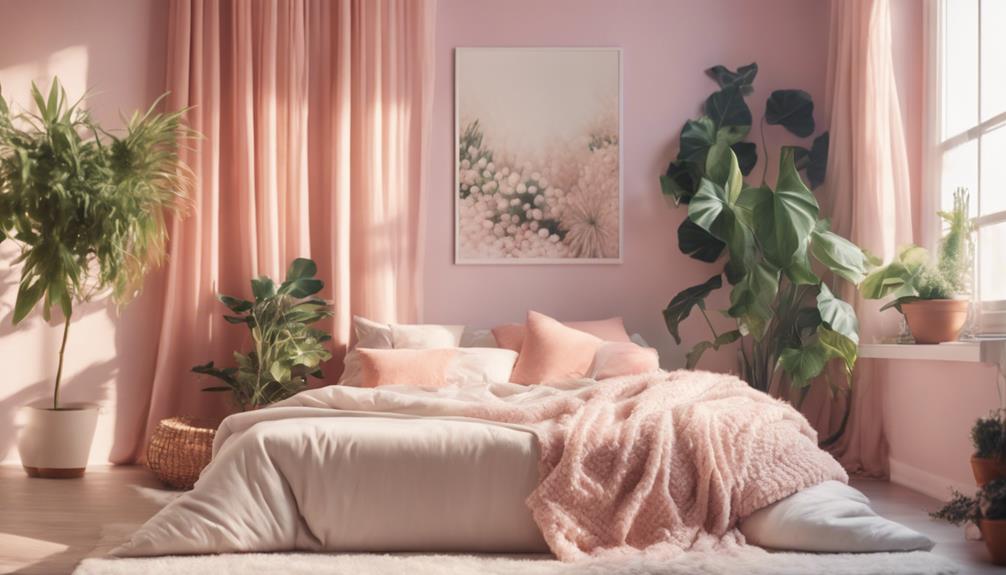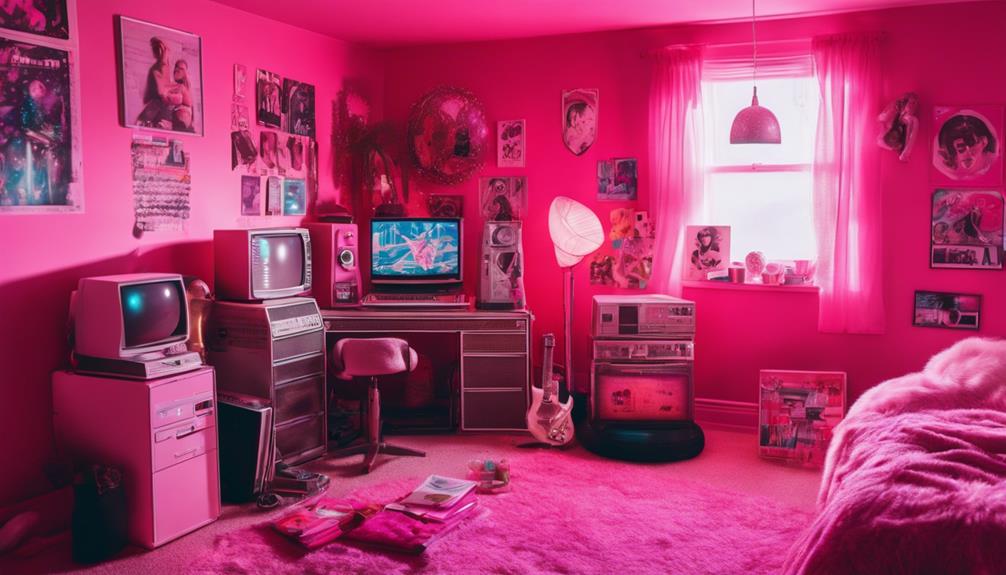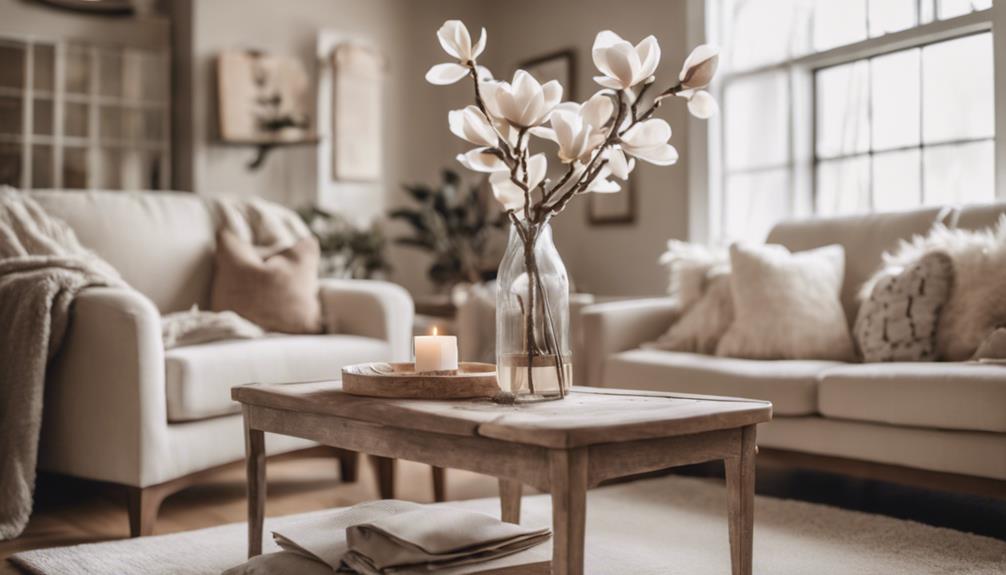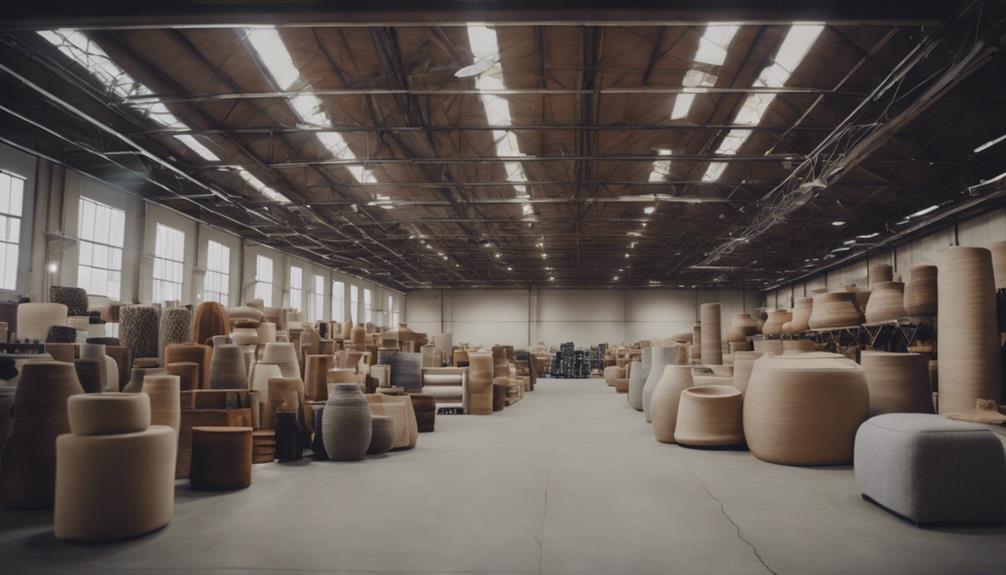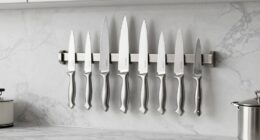Art Hoe Room Decor ignites your space with vibrant colors and artistic expressions that reflect your creative spirit. Start by choosing bold color schemes, mixing primary hues with natural greens. Incorporate textured textiles, like floral bedding and throw pillows, alongside natural materials like wood and ceramics. Don't forget to include indoor plants for a fresh vibe! Add creative lighting options like neon lamps or fairy lights to set the mood. With colorful art pieces and handmade ceramics, you can create an inspiring atmosphere. Keep exploring to uncover more ideas that enhance your unique artistic style!
Key Elements

When creating your Art Hoe room decor, focus on a vibrant color scheme that blends primary colors with natural greens.
Use a mix of materials and textures to add depth and interest, ensuring each piece contributes to the overall aesthetic.
These key elements not only enhance your space but also reflect your unique artistic flair.
Color Scheme
A vibrant color palette is essential for Art Hoe decor, featuring primary colors like red, yellow, and blue, along with nature-inspired greens to foster a lively and creative atmosphere. Your color scheme can include all the colors of the rainbow, allowing you to express your individuality and artistic flair.
Lighter wall colors, such as white or beige, work well to enhance the vibrancy of your artworks and decor elements, making them truly pop. To create a cohesive and inviting ambiance, consider incorporating floral patterns and nature-inspired tones in your textiles and accessories. This not only adds depth to your color scheme but also evokes the lushness of a garden, making your space feel more alive.
A balanced mix of bold colors and neutral backgrounds fosters a harmonious environment that encourages artistic expression and personal creativity. Ultimately, the right color scheme sets the tone for your Art Hoe room, reflecting your unique style and making your space a true representation of who you are.
Embrace the colors that inspire you, and let your creativity shine through your decor!
Materials
Incorporating natural materials like wood and vibrant textiles brings an invigorating energy to your Art Hoe room decor. Using wood for furniture not only adds warmth but also creates a connection to nature, enhancing the overall aesthetic. Choose pieces that showcase the natural grain and texture, which can serve as a beautiful backdrop for your colorful art displays.
Consider adding indoor plants, such as succulents or sunflowers, which breathe life into your space. These materials not only contribute to a fresh atmosphere but also serve as striking decor elements that reflect your artistic personality.
For your walls, stick to neutral shades like white or beige to maximize the impact of your decor. This canvas allows the vibrant colors of your art and textiles to shine, creating a lively environment.
Don't forget about decorative items—canvas artworks, polaroids, and music posters are essential materials that express your creative side. By thoughtfully combining these materials, you'll cultivate a unique ambiance that resonates with your individuality and artistic flair.
Embrace these elements to truly make your Art Hoe room a personal sanctuary.
Textures
Textures play an essential role in enhancing the cozy and inviting atmosphere of your Art Hoe room decor. By incorporating soft fabrics like floral bedding and cushy throw pillows, you create a warm, welcoming space. Natural materials, such as wooden furniture and ceramic vases, add earthy textures that beautifully complement the vibrant colors of your aesthetic.
Layering different textures can elevate your room's visual interest. For instance, a smooth tablecloth paired with a patterned tapestry creates a dynamic contrast that reflects your artistic flair. Additionally, textured wall decor, like canvas prints and abstract designs, adds depth and dimension, making your space feel more alive.
Combining various textures—such as sleek glass candle holders alongside rough stone planters—contributes to a harmonious and eclectic decor style. It invites curiosity and encourages creativity. Don't shy away from mixing textures; they can transform your room into a unique reflection of your personality. Embrace the playfulness of textures, and watch your Art Hoe room come to life with character and charm.
Essential Fixtures and Furniture

When designing your Art Hoe room, think about incorporating essential fixtures like a vintage wooden easel, a vintage art cart, and a colorful art stool.
These pieces not only serve practical purposes but also enhance the creative vibe of your space.
Vintage Wooden Easel
A vintage wooden easel often serves as both a practical art tool and a striking focal point in your art room decor. These easels, typically crafted from sturdy hardwoods, support canvases of varying sizes, making them perfect for both displaying your masterpieces and painting new ones. The unique craftsmanship of many vintage wooden easels, complete with intricate details, can easily become a conversation starter, enhancing the overall ambiance of your artistic space.
When you choose a vintage wooden easel, you're not just adding a functional piece; you're also embracing a sustainable choice. By promoting the reuse of quality materials, you reduce the demand for new production, aligning with eco-friendly values. Plus, investing in such a timeless piece can be a rewarding experience, as prices for vintage wooden easels can range from $50 to several hundred dollars, depending on age, condition, and craftsmanship.
Incorporating a vintage wooden easel into your decor allows you to express your creative side while showcasing your commitment to artistry and sustainability. So go ahead, find that perfect vintage easel, and let it inspire your artistic journey!
Vintage Art Cart
Vintage art carts offer a chic and practical way to organize your art supplies while adding a unique touch to your creative space. These stylish storage solutions keep your paints, brushes, and canvases easily accessible, enhancing both functionality and aesthetic appeal. Typically crafted from materials like wood or metal, vintage art carts often feature distinctive designs and finishes that reflect their era's craftsmanship, giving your room character.
One of the best things about a vintage art cart is its mobility. Many come with wheels, allowing you to rearrange your workspace effortlessly whenever inspiration strikes. This versatility is perfect for artists who need to adapt their environment to suit their creative flow.
Using a vintage art cart promotes organization, encouraging a clutter-free workspace that's essential for maintaining focus during artistic endeavors. Plus, it can serve as a conversation piece, showcasing your appreciation for art history and design trends from past generations.
Colorful Art Stool
Colorful art stools not only provide functional seating but also inject a lively burst of personality into your art hoe room decor. These stools come in a variety of designs and colors, making it easy to find one that complements the vibrant palette of reds, yellows, and blues typical of an art hoe aesthetic bedroom.
Whether you prefer a bold, abstract pattern or a more subtle design, a colorful art stool can serve as a striking focal point in your space. Made from durable materials, these stools are built to withstand regular use while maintaining their eye-catching appearance.
Plus, they offer a fantastic way to creatively display your artistic tools—think paintbrushes and sketchbooks—making them a multi-functional addition to your decor. When you choose a stool with a unique pattern or artistic design, you further emphasize your personal style and passion for creativity.
Ultimately, a colorful art stool not only enhances your room's aesthetic but also encourages a vibrant, artistic atmosphere that inspires you every day. So, don't hesitate—add that pop of color and functionality to your art hoe aesthetic bedroom!
Lighting Ideas

When it comes to lighting for your art hoe room, you'll want to think creatively about how to set the mood.
Soft pastel pendant lights and colorful neon floor lamps can add a playful touch, while a hanging fairy light canopy brings a dreamy vibe.
Don't forget color-changing LED strip lights to give your space that vibrant, artistic flair!
Soft Pastel Pendant Lights
Soft pastel pendant lights beautifully enhance the art hoe aesthetic, casting a warm glow that complements the vibrant color palette of your decor. Available in shades like mint green, blush pink, and soft yellow, these lights create a serene ambiance while keeping the space playful. You can easily use soft pastel pendant lights as statement pieces, drawing attention to areas like art displays or cozy reading nooks.
Many designs feature unique shapes, such as geometric or floral patterns, which align perfectly with the artistic and nature-inspired elements of this aesthetic. These eye-catching designs not only provide illumination but also serve as conversation starters.
If you want versatility, consider incorporating soft pastel pendant lights with dimmable options. This feature allows you to adjust the lighting levels, making it easy to shift from studying to relaxing.
Colorful Neon Floor Lamps
Neon floor lamps inject a lively burst of color into your art hoe room decor, perfectly matching the aesthetic's celebration of vibrant hues and creativity. These colorful neon floor lamps not only brighten your space but also serve as striking focal points that enhance your artistic vibe. Available in shades like pink, blue, and green, they align seamlessly with the art hoe color palette, making your room feel more inviting and expressive.
Many of these lamps feature adjustable brightness settings, allowing you to create the perfect ambiance for your creative activities, whether you're painting, drawing, or just hanging out. The unique shapes and styles of colorful neon floor lamps add an additional layer of visual interest, transforming a simple lighting fixture into a statement piece.
Incorporating these eye-catching lamps into your decor elevates the overall atmosphere, encouraging inspiration and artistic expression. So, when you're looking to amplify your art hoe aesthetic, colorful neon floor lamps are a fantastic choice that blends functionality with flair, providing both light and a vibrant touch to your personal haven.
Hanging Fairy Light Canopy
A hanging fairy light canopy adds a whimsical touch to your art hoe room, creating a cozy ambiance that complements the lively atmosphere established by colorful neon floor lamps. This enchanting decor element can transform your space, immersing it in a warm, inviting glow. You can easily customize these canopies with string lights draped in various patterns, allowing you to express your individual style.
Many fairy light canopies are battery-powered, which means you won't need to fuss with electrical outlets during installation. This flexibility is perfect for your creative space!
To enhance your art hoe room decor further, consider incorporating natural elements like greenery or art displays alongside the fairy lights. This combination creates a harmonious blend of nature and artistic expression, making your room even more inviting.
The soft illumination from the fairy lights beautifully highlights your wall art and personal pieces, showcasing your creativity. Whether it's a cozy reading nook or an art display area, a hanging fairy light canopy can elevate the overall aesthetic, making your art hoe room a true reflection of your unique personality.
Color-Changing LED Strip Lights
Color-changing LED strip lights bring a vibrant, customizable glow to your art hoe room, perfect for matching your mood or decor theme. With the ability to select from millions of colors, you can easily create the ideal atmosphere for relaxing, working on art, or hosting gatherings.
These lights are incredibly versatile; you can install them along walls, shelves, or furniture to enhance the overall ambiance and highlight your artwork.
What's more, many color-changing LED strip lights come with remote control or smartphone app functionality, allowing you to adjust brightness, color, and lighting effects with ease. This convenience means you can switch up the vibe without getting up.
Plus, they're energy-efficient and long-lasting, consuming considerably less power than traditional incandescent bulbs, making them a sustainable choice for your decor.
For an interactive twist, consider LED strips that sync with music or create dynamic lighting patterns. This feature transforms your space into an immersive environment, perfect for inspiring creativity during art sessions or lively gatherings with friends.
With color-changing LED strip lights, your art hoe room will truly reflect your unique style and energy!
Decorative Elements

To elevate your art hoe decor, think about incorporating colorful framed artwork that reflects your unique style.
Hand-painted ceramic wall plates can add a touch of personality and charm, while a colorful beaded wall hanging brings texture and warmth to your space.
These decorative elements not only enhance the visual appeal but also create a cozy, inviting atmosphere.
Colorful Framed Artwork
Colorful framed artwork often serves as the vibrant focal point of Art Hoe room decor, instantly elevating the space's aesthetic. By incorporating a mix of styles like abstract, floral, and geometric designs, you can express your unique creativity and personality through your decor. Choose frames in bold primary colors such as red, blue, and yellow to complement your room's color palette, enhancing the overall visual appeal.
Layering different sizes of colorful framed artwork creates visual interest, transforming your walls into a dynamic display reminiscent of an art gallery. Don't be afraid to experiment with various arrangements until you find the perfect layout that resonates with your artistic flair.
Moreover, incorporating inexpensive DIY techniques allows you to add a personal touch without straining your budget. Frame your own artwork or hunt for thrifted finds that speak to you; these pieces can add character and depth to your space.
Hand-Painted Ceramic Wall Plates
Hand-painted ceramic wall plates add a unique and artistic touch to your Art Hoe room decor. These stunning pieces often feature vibrant colors and intricate designs, turning them into eye-catching focal points on your walls. They seamlessly blend the themes of art and nature, enhancing the overall aesthetic of your space.
You can arrange hand-painted ceramic wall plates in a gallery wall style, mixing them with other art pieces, polaroids, and postcards to create a cohesive display that reflects your personality. This arrangement not only showcases your creativity but also celebrates cultural appreciation and craftsmanship, central to the Art Hoe ethos.
Sourcing these plates from local artisans or vintage markets supports independent artists and promotes sustainable decor practices. By incorporating hand-painted ceramic wall plates, you're not just decorating; you're telling a story that honors diversity and creativity.
Colorful Beaded Wall Hanging
If you're looking to infuse your space with vibrant energy, a colorful beaded wall hanging can serve as a stunning focal point that enhances the artistic vibe of your room. These colorful beaded wall hangings come alive with primary colors and intricate designs, instantly transforming a bare wall into a canvas of creativity.
Crafted from a mix of materials like wood, glass, and natural fibers, they offer diverse textures that elevate your decor. Not only do they draw the eye, but they also spark conversation, showcasing your personal style and artistic expression. You can easily customize or DIY your own colorful beaded wall hanging, allowing you to create a unique piece that resonates with your vision.
Incorporating these decorative elements aligns perfectly with the art hoe aesthetic, emphasizing inclusivity and celebrating diverse cultural influences through art. Whether you hang one over your bed, in a cozy reading nook, or as part of a gallery wall, colorful beaded wall hangings will surely enhance your space and inspire creativity.
Flooring

When picking flooring for your Art Hoe room, think about painted wooden floorboards that add character and warmth.
Textured area rugs can bring in color and comfort, making your space feel inviting.
Brightly colored vinyl planks also offer a playful vibe while being easy to maintain, perfect for your creative haven.
Painted Wooden Floorboards
Painted wooden floorboards can transform your art hoe room into a vibrant canvas, allowing you to express your creativity through bold color choices and unique designs. By opting for primary colors like red, blue, and yellow, you can create a cohesive look that aligns perfectly with the art hoe aesthetic. These lively hues not only enhance the overall vibe but also serve as a dynamic backdrop for your decor elements, such as artwork and plants.
Choosing a semi-gloss or satin finish for your painted wooden floorboards won't only add durability but also provide a subtle sheen that reflects natural light, making your space feel even more inviting. To keep your floorboards looking fresh and visually appealing, regular maintenance is key. Touch-ups and resealing will guarantee that your artistic expression remains intact over time.
Incorporating painted wooden floorboards into your room decor is a fantastic way to showcase your creative side while enhancing the ambiance of your space. Embrace the chance to turn your floor into an art piece that resonates with your personality and artistic vision.
Textured Area Rugs
Textured area rugs elevate your art hoe room decor by adding warmth and depth, perfectly complementing the vibrancy of painted wooden floorboards. Incorporating tactile elements, these rugs enhance the overall aesthetic of your space, making it feel inviting and creatively charged.
Opt for bold patterns or colors to create a striking focal point that ties together various decor elements. Popular materials like cotton, jute, or wool not only provide durability but also contribute to that cozy, eclectic vibe you're aiming for.
Layering is another great technique—try placing a smaller, patterned rug over a larger, solid-colored one to boost visual interest and emphasize your unique style.
To keep your textured area rugs looking fresh, regular maintenance is key. Make sure you vacuum frequently and perform occasional spot cleaning to preserve their integrity and appearance.
This attention to detail guarantees your rugs remain a vibrant part of your art hoe aesthetic, contributing to a dynamic and engaging environment. By thoughtfully selecting and caring for your textured area rugs, you'll create a space that truly reflects your creative spirit.
Brightly Colored Vinyl Planks
Brightly colored vinyl planks can transform your space, infusing it with vibrant hues that perfectly match the lively art hoe aesthetic. These planks come in various colors and patterns, allowing you to create a floor that reflects your unique style. Whether you prefer bold reds, bright yellows, or deep blues, there's a perfect shade to complement your decor.
Vinyl planks aren't just visually appealing; they're also practical. They're durable and water-resistant, making them ideal for high-traffic areas where creativity and activity thrive. You won't have to worry about spills or wear and tear, ensuring your artistic sanctuary remains inviting.
Installation is a breeze, thanks to their click-lock system. If you're a DIY enthusiast, you'll appreciate how easily you can personalize your space. Plus, brightly colored vinyl planks can help create a cohesive look, tying together floral patterns, artistic wall hangings, and other decor elements.
With their variety of textures and designs, including wood and abstract styles, brightly colored vinyl planks allow you to express your creativity and enhance the overall aesthetic of your room. Immerse yourself in this flooring option and let your artistic side shine!
Conclusion
Incorporating art hoe room decor lets you express your creative spirit while creating a vibrant and inspiring space.
By blending essential fixtures, thoughtful lighting, and unique decorative elements, you can transform any room into a true reflection of your personality.
Don't forget to contemplate your flooring, as it sets the foundation for your artistic haven.
Embrace your creativity and let your room become a canvas that showcases your individuality and passion for art!

